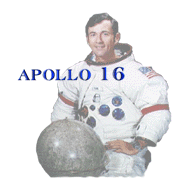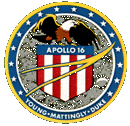
|

|
This page last updated |

|

|
This page last updated |

|
Apollo 16
AS-511
|
| 1 | 2 | 3 | 4 | 5 | 6 | 7 | 8 | 9 | 10 | 11 | 12 | 13 | 14 | |
| 15 | 16 | 17 | 18 | 19 | 20 | 21 | 22 | 23 | 24 | 25 | 26 | 27 | 28 | |
| 29 | 30 | 31 | 32 | 33 | 34 | 35 | 36 | 37 | 38 | 39 | 40 | 41 | 42 | Links |

Young, Duke Utilize Rover Racetrack, Lunar Surface Training Area At KSC
KSC Spaceport News - April 6, 1972When Apollo 16 Commander John W. Young and Lunar Module Pilot Charles M. Duke emerge from the Lunar Module to begin their exploration of the Moon's Descartes region on April 20, they will be accomplishing mission objectives practiced many times before.
Young, Duke and Command Module Pilot Thomas K. Mattingly have been almost permanent residents of KSC for the past three months, practicing every aspect of their lunar journey in the command module and lunar module simulators in the Flight Crew Training Building.
Additional reality has been brought to the tasks of Young and Duke in training for the 21 hours of extravehicular activity (EVA) during which they will make three ambitious motorized traverses of the Cayley Plains nestled in the rugged Descartes highlands.
At launch time, Young and Duke will have each spent approximately 500 hours on lunar science training, 150 hours of which will have been spent at the Spaceport's Lunar Surface Training Area.
The Lunar Surface Training Area is a sandy, palmetto-fringed tract located immediately south of the Flight Crew Training Building.
It is here that Young and Duke have practiced deployment of the comprehensive experiments of the Apollo Lunar Surface Experiments Package (ALSEP) and driven a one-gravity version of the Lunar Roving Vehicle (LRV) over a 2 kilometer (1.25 mile) course dubbed the " Rover Racetrack" .
"They receive close to 500 hours of lunar science training." said Larry Thompson, Chief of Flight Crew Operations.
"This breaks down to roughly about 150 hours they will spend here going through EVA training, using our lunar module mockup and the outside facilities we have here. About 200 hours is spent on field trips to various parts of the world to study different types of rock formations and the remainder is spent in detailed briefings given by some of our leading geologists.
"When they get done you might say they just about have a degree in geology, " said Thompson.
The Lunar Surface Training Area includes simulated craters and is strewn with rocks and boulders to provide realism. The "racetrack'' is studded with boulders, lengths of utility poles and assorted debris to give the Rover crew practice in making series of tight steering maneuvers.
Rocks are as rare as snowballs in this portion of Florida and the geological sites in the training area and along the traverse rouse were constructed with the aid of imported materials emplaced with the aid of a team of geologists from the U. S. Geological Survey.
The imported materials include:
-Two train car loads of volcanic cinders and boulders from the Flagstaff, Arizona area.
-One train car load from California, representative of the types of rocks to be found in lunar upland areas.
-One dump truck load of granite and basalt rocks from quarries located in South Carolina and Georgia, and
-Approximately 800 pounds of special breccia type rocks from an area near Austin, Texas. (Breccia consists of sharp rock fragments embedded in a finegrained material.)
The course includes three EVA stations, gentle mock "craters" strewn with "lunar debris".
"The course and the geology stations are not designed as an actual duplication of the Descartes traverses," said Maurice Walters, a simulations engineer for the Manned Spacecraft Center assigned to KSC, "but merely a simulation of conditions which might be found at the landing site."
An area to the south of the Training Building includes specialized facilities in which deployment of the ALSEP and drilling for core samples can be simulated. Training zones have been so placed that it is possible to approximate the angle of the sun striking the lunar surface during specific work periods.
This area includes 3.65 meter (12 feet) deep drill tubes in which the crew practices taking core samples with a drill. These are packed with sand, rocks and simulated debris and tamped down to duplicate the hardness of the lunar soil.
The EVA exercises call for Young and Duke to rehearse their lunar tasks fully suited and suits, plus backpacks, are quite heavy under the Earth's one-G gravity loading.
"We have reduced the weight of the backpack somewhat to take some of the load off the crewmen while they are performing their EVA exercises," said Thompson. "John Young, fully suited with backpack and gear, weighs out at about 340 pounds here on the Earth. And it's quite a big load to carry around for a four to five hour session. So we've reduced that backpack about 40 pounds on his one-G exercises."
|
|
| 1 | 2 | 3 | 4 | 5 | 6 | 7 | 8 | 9 | 10 | 11 | 12 | 13 | 14 | 15 | 16 | 17 | 18 | 19 | 20 | 21 | |
| 22 | 23 | 24 | 25 | 26 | 27 | 28 | 29 | 30 | 31 | 32 | 33 | 34 | 35 | 36 | 37 | 38 | 39 | 40 | 41 | 42 | Links |
Home Biography Missions Appearances Bibliography Site Map Critique this site! Other Astros
John W. Young - American & International Hero Title Page
Page created by Dana Holland - webmaster @ johnwyoung.org
Dana's Page
This site is for informational and educational purposes only. It is NOT sanctioned by John Young, NASA, or Navarro College.